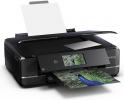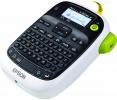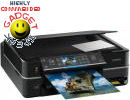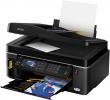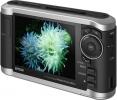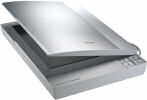Reviews related to : Epson
The Epson WF7715DWF is a versatile A3+ multi-function inkjet that will meet the needs of the majority of small offices
Although A4 is the basic office norm there are occasions when being able to handle A3 would prove to be useful. For example one could work with larger spreadsheets as well as printing two A4 pages onto each A3 sheet and then fold to make a booklet which is much more business-like that separate A4 pages. Being A3+ with an automatic document feeder (ADF) it can be appreciated that this machine, while suitable for the smaller office, may not fit into the smallest one.
This is a very small A3 All In One unit. For my review time it sat on top of my own A4 All In One and only overlapped by a small degree. So it can of course still print A4 as well as the larger A3, it is a six ink offering and for good measure will print on CD’s and DVD’s.
It is 46x36x14cm when closed, A4 paper is stored internally near the base, A3 paper will need the sit up poke up from the back tray so more height will be required for that and unless you are adept at poking a sheet of paper into the lift up scanner bed then a little extra for that especially if you are scanning from a book.
Having looked at and used Epsons first foray into health via watch that lets you log your pulse as well as much more I am here looking at another device, this one aimed at those whose aim is to get fit as well as those who just try to survive.
This is somewhat larger at 4.5x5x1.5cm and it weights 51grams. The dial is round and has four buttons on the sides in the 2, 4, 8 and 10 o clock positions, the watch display is digital and will not be correct until it gets a satellite fix. The initial setup on the watch consists of language, units, height, weight, DOB, gender, year, month and day. Finally something that has yet to reach its sibling the Pulsense date format.
For around £500 you can pick up a very decent entry-level projector built around Texas Instruments' Digital Light Processor (DLP), an ingenious electromechanical device that turns electrical signals into pictures. I've reviewed several such machines here over the past year or so, ranging up to the £3,000 mark. But if you're shopping around in that area it's definitely worth considering the very different approach pioneered and promoted by Epson. This uses three separate electrical signal to light converters operating simultaneously, one for each of the primary colours. At the entry level end of the market Epson's 3LCD technology requires compromises. But if you're prepared to shell out a couple of grand or so, Epson's near top-of-the-range EH-TW9200 3LCD projector should be a serious candidate.
Weighing in at 8.4Kg and measuring 140 x 466 x 395 mm (height, width, depth) this is definitely a whale of a machine, particularly in comparison with the tiny Viewsonic PLED-W800 I reviewed here recently. It has a full complement of inputs: two HDMI sockets, component video, D-Sub PC, S-Video and composite. It's currently sitting on top of a Yamaha RX-V677 AV receiver but I would hesitate to perch it on any less well-built piece of equipment.
I think of Epson as a producer of printers and projectors, their parent company is Seiko so timing systems and quality watches are their bag. Here however a health product that combines a watch with a whole range of other features.
When a company known for something launches a new product in a different field it always takes a while to bed in. This product from Epson is no exception. There are a range of products on the market in fitness and health, none that I know on can do everything that Epson is trying to do in a single product.
Very decent home cinema projectors can now routinely be had for around 500 quid. But how do you pick a winner you'll be happy to live with from this cheap and cheerful bunch? As the TV industry hurries us ever upwards towards 4K (four times the number of pixels in a regular HD TV screen) punters tend to view pixel count as the prime requirement. Chris Bidmead thinks there are more important factors to look out for.
Epson's entry level EH-TW490 is "HD Ready". It's a confusing industry label (designed to confuse?) that in this case means it projects a screen into which it's possible to fit a 720x1280 pixel matrix with a few pixels to spare at the top and bottom. Hang on, though? Isn't that not much more than half what a true 1080p HD screen ought to be? And can't I pick up a proper 1080p projector for around the same price? The answers are yes and yes. And my response is fergetaboudit.
The EH-TW480 is a portable HD-ready cinema projector targeted at the home user. It provides high quality bright images even in daylight and, with features such as automatic vertical keystone correction, it is simple to set up and use. Consequently, despite it being in Epsons Home range, it could well have a wider application.
It is a relatively small unit, black in colour, weighing 2.3kg. Roughly 30 x 23 x 8 cm it is provided with a padded case with shoulder strap but more of that later. When not in use, a cover can be slid across to protect the lens. Known as the A/V mute slide, it can also be used during projection to hide the image and mute the sound. The projector is a HD-ready 720p, 1280 x 720 LCD unit having a 2,800 lumen output and a claimed contrast ratio of 3000:1.
A multi function unit as it has Fax, when I speak with manufacturers they still claim there is demand, my findings are somewhat different, this is rather like the PX730 recently reviewed but this is black rather than cream.
The Epson PX830 MFU measures 44x50x20cm the rather large depth figure is solely because of the built in Duplex that adds to the depth, the colour may put some off but if it resides in a cupboard then it need not be seen. The wireless option works very well. The whole control panel 30x8cm flips from vertical to horizontal hinging on the top so is viewable from any angle. With the exception of the on/off button which is to the left of the huge 21x6cm screen everything is controlled by touch.
When you think of label printing you tend to think of Dymo, as I discovered earlier this year Brother makes label printers and now I find so do Epson, here I am looking at their latest offering the Epson LabelWorks LW-400.
Of course early label printers were onto impressed metal and you stamped them out one at a time with a revolving wheel, yes I know even Dymo moved into the 21 century but this unit is more like a tiny computer as you are able to store designs, templates and it can even print barcodes all on adhesive tape strips. It is 17x12x6cm and weights 456grams. Mine was a creamy white with black keyboard and a sort of lime green button on the side.
My recent print jobs have been carried out by a new Epson multifunction device. Read my report.
The Epson BX635FWD is a 4-in-1 multifunction device that Epson describes as being the ideal office printer. Providing print, copy, scan and fax capabilities, this product allows for USB, Ethernet or Wi-Fi connection to your computer system. You also get an ADF and duplex printing functionality. Recently this multifunction device has been taking over the various print, scan, copy and fax duties for my home office.
It has been a long time since I last had the opportunity to check out an Epson printer. If memory serves me correct (actually it was a more reliable Filemaker database that provided the information), the last model was one of the Perfection series that were current four years ago. The arrival of the Epson BX320FW model saw an end to this situation.
Opening the fairly large box revealed a predominately matt black multifunction unit offering print, scan, copy and fax features with an ADF (Automatic Document Feed) unit. Looking like it might put a strain on my fragile back, I was pleased to discover that the actual weight of the unit was less than its initial appearance suggested. Weighing 7.
I see only a few A3 printers mainly because of size but after the recent offering from Brother this Epson unit was offered, it is bigger (wider) than the Brother and is only a printer and not an All In One but it can print A3+.
The overall dimensions of the Epson B1100 A3 printer, when the paper input and output trays are open, is 61x45x34cm when closed it is 61x20x32cm. The top front edge has a round on/off button with internal LED and three rod buttons are the rest of the unit’s controls. The back right is where the power lead enters and about 1/3 of the way along the back from the left is where the USB lead enters.
It has been a while since I had the chance to look at an Epson unit. In fact I first saw this last summer and it has taken till well into the New Year and a lot of nagging for it to get to me. So a simple question was it worth the wait?
The Epson Stylus PX710W is very compact for an A4 All In One unit at only 43x45x14cm with cables inserted. The only extra space you will need is around 15cm in front when it is printing. It is totally black so it might not meet with approval from the lounge police. Not only is it a standard All In One unit but it can do all sorts of fancy things to images that standard units cannot. There are a total of 20 buttons on a lift up portion of the front 25x6.
This is a multi function machine (includes fax) that can be connected via USB or wirelessly. My own opinion is that very few still use fax but as these machines (with fax) are still produced I must by wrong.
The Epson SX600FW multi-function unit measures 47x39x22cm the latter figure the height will increase by around another 9cm with A4 paper loaded in the rear vertical position. With the control panel tilted up this adds 4cm to the second figure the depth. It is black so it will pass very few of the lounge police. The top has both a flatbed and a sheet feed and in a very nice touch the sheet feed can be closed to produce a nice flat top when not required.
Not a photo frame that currently seems in vogue but a device solely for the display of images. What has an object not that much larger than a camera have that a decent photo frame does not?
The Epson P-3000 measures 14x5x8.5x3.5cm and weights 420grams. The display window is 8.3x6.1cm giving the notional 4inch display. It runs on a solid rechargeable battery. The top has earbud socket, SD and Compact Flash card slots. The right side has on/off hold slider as well as a Kensington Lock connector. The base has the entry point for the solid battery, while the left side has two rubber bungs covering the power adapter and A/V outlet and USB sockets.
This is purely a photo printer and one thats maximum paper size is 15x10cm. However it is extremely easy to use it does one job, it does it well and it does it quickly.
While this can of course be connected to a PC it is not essential. It can just work anywhere there is a 13amp power plug. It is 21x16x14cm when closed. In use the first figure the width does not change. The last figure the height increases by 13cm when the lid is opened to form a backplane for the stored paper waiting to be printed, and this together with the front dropping down to reveal the card slots and tray for the images adds 11+12cm.
While this may look like just another All In One it does have the odd surprise of two. Certainly the silver grey top and black for everything else is unlikely to pass the lounge police unless he/she is of the Goff persuasion.
The Epson RX585 all-in-one printer is 43x43x19cm but once you put paper in the tray (vertical at the back) this adds 14cm to the last figure the height. Installation is reasonable although it does have several (linked) parts and once started just make a cup of coffee and look in on it a few times.
This is quite a squat unit, it will never pass the lounge police as it is very dark grey, so if not in an office into a cupboard never to see the light of day.
It is 44x34x16cm the latter figure the height increases by 18cm when there is paper in the rear vertical tray waiting for printing. This is an All In One unit as it prints copies and scans. There is no fax capability so it's not a Multi Function unit. As always the first set of Epson cartridges (four colour four cartridges unit) last very little time as a good proportion go on the initial charge.
While All-in-One or multifunction devices continue to be the flavour of the month with both retailers and consumers, there is still a place for various standalone devices.
If you have the work space and an interest in photography then you might well prefer the specific functionality that is provided by a dedicated scanner. A recent example of this specific scanning functionality can be found in the Epson Perfection V200 model which provides the means to scan general documents, photos, film strips, slides and even 3D objects with a scan resolution of 4800 x 9600 with 48 bit colour.
Unlike multifunction devices, where the scanner is usually a bolt-on basic unit, a dedicated scan can provide additional features.
It has been quite a while since I last had the opportunity to try out a new standalone flatbed scanner. The main reason for this long gap is down to the popularity of multifunctional and all-in-one devices. These types of product do have the decided advantage of saving on workspace and power source requirements. However there are occasions when the specific functionality of a dedicated scanner outweighs these considerations.


